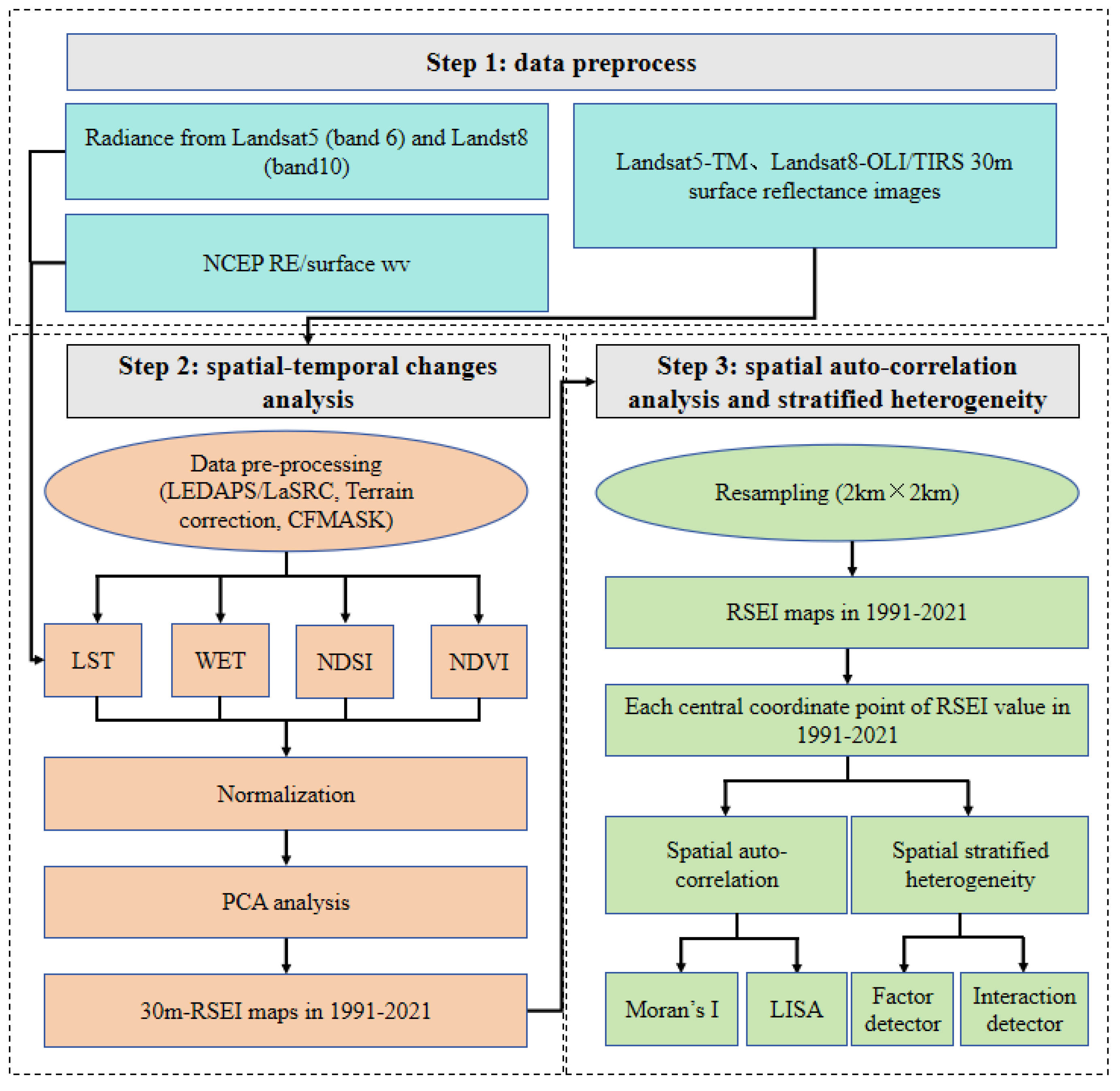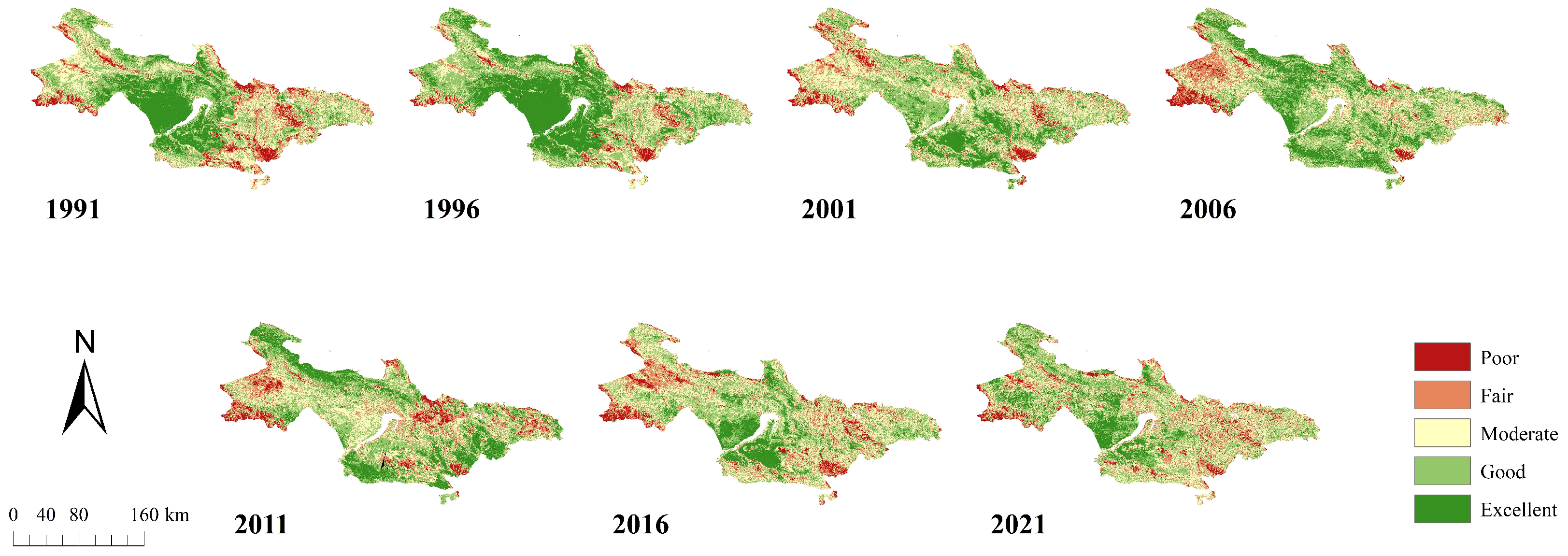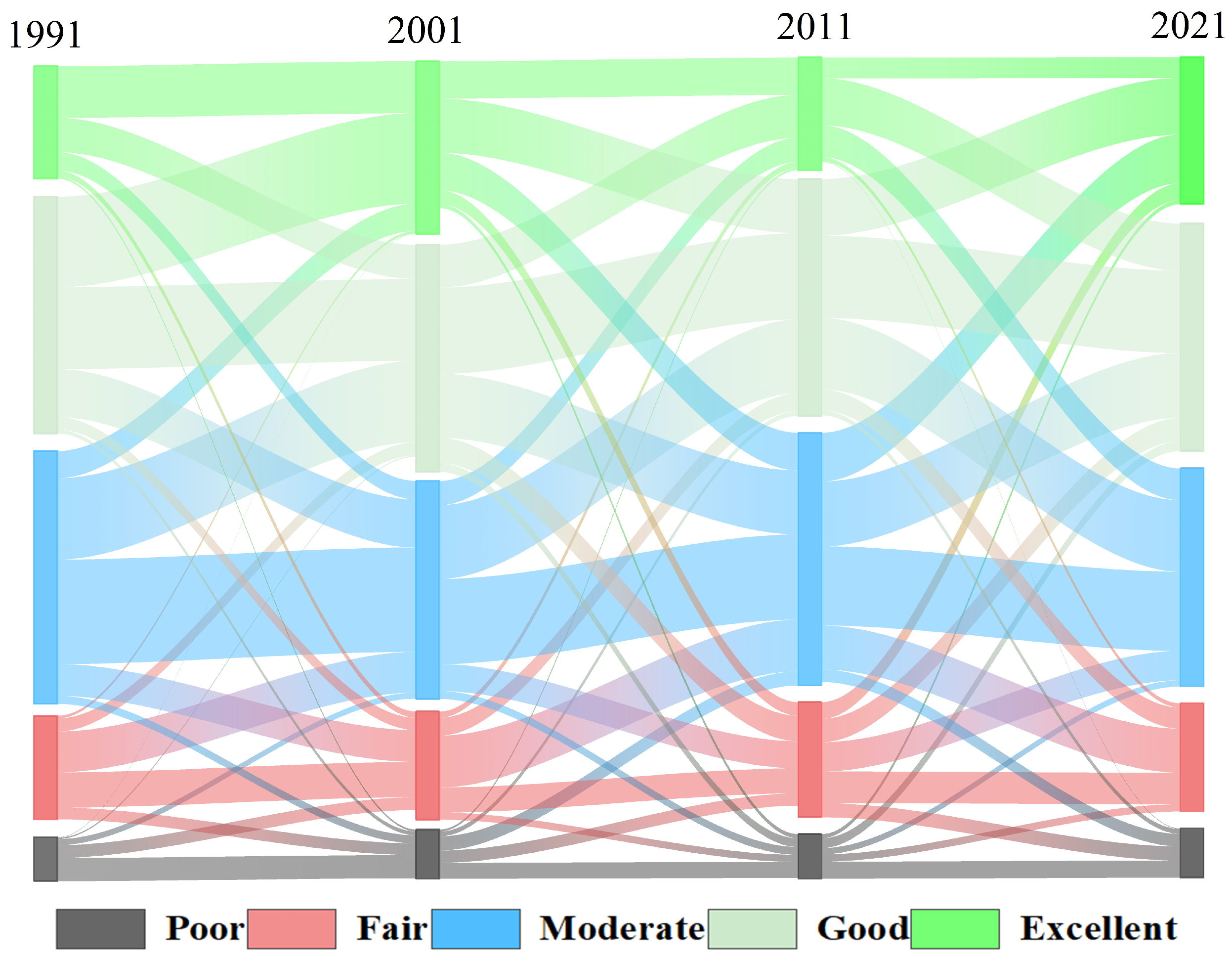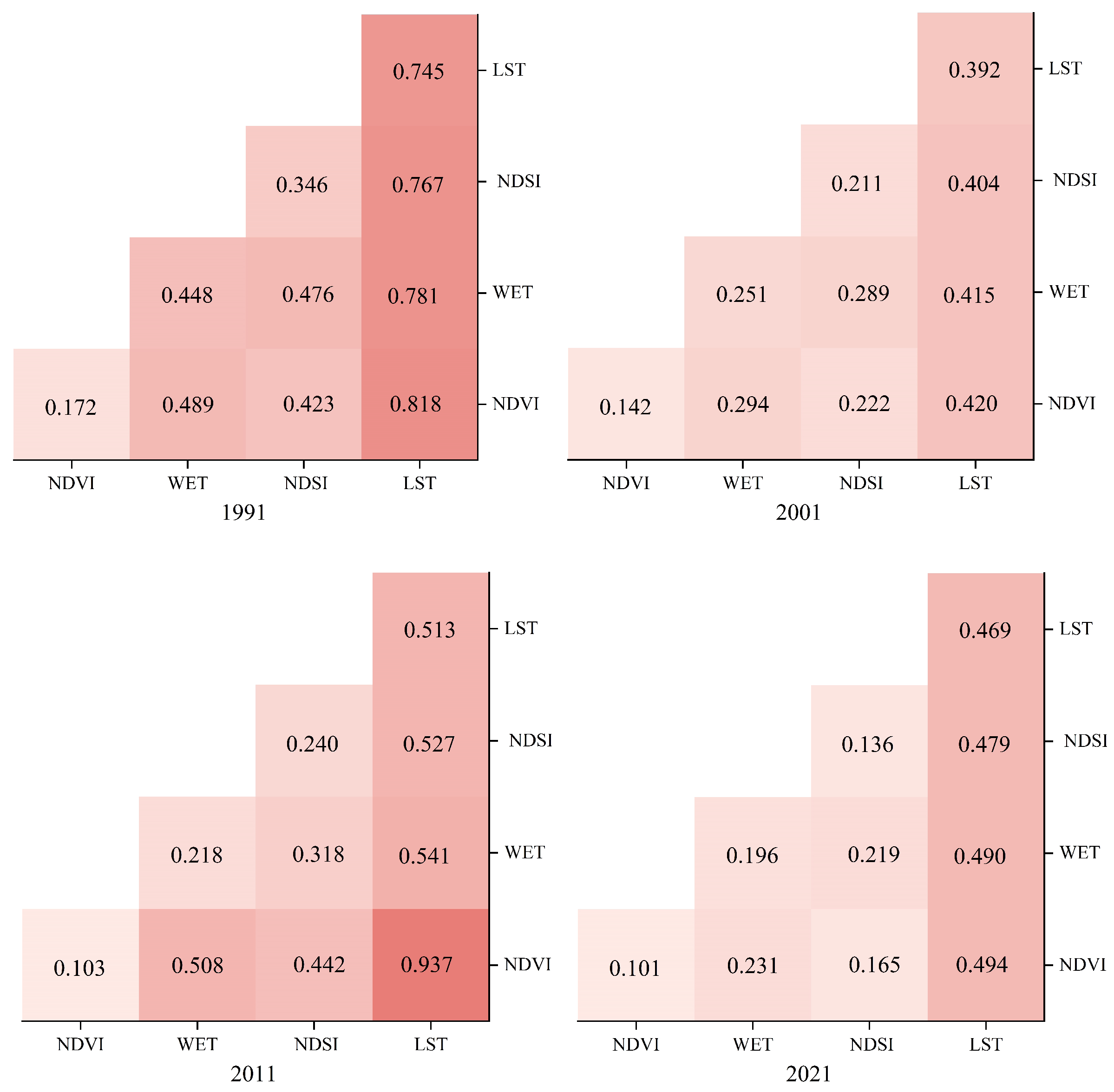Spatiotemporal Evolution and Spatial Analysis of Ecological Environmental Quality in the Longyangxia to Lijiaxia Basin in China Based on GEE
Abstract
:1. Introduction
2. Materials and Methods
2.1. Study Area
2.2. Data and Preprocessing
2.3. Methodology
2.3.1. Establishment of Remote Sensing Ecological Index
| Index | Formula | Explanation |
|---|---|---|
| WET | WET is a measure of transformed humidity that is indicated by the Tasseled Cap Transformation (TCT); are reflectance values of the blue, green, red, near-infrared, shortwave infrared 1, and shortwave infrared 2 bands, respectively; are sensor parameters [35,36]. | |
| NDVI | NDVI is a commonly used vegetation index for visualizing plant cover; and represent reflectance values of the near-infrared and red bands, respectively [37,38]. | |
| NDSI | NDSI is calculated by averaging the Index-based Built-up Index (IBI) and Soil Index (SI); , , , and are reflectance values of the shortwave infrared 1, near-infrared, green, red, and blue bands, respectively [39,40]. | |
| LST | LST is the surface temperature obtained from the atmospheric correction method and inverted according to the Landsat manual and the corresponding parameters; T is the temperature at the sensor and is m·K; is the surface specific emissivity; and are the predefined calibration parameters at the time of the satellite launch, respectively; is the central wavelength of the thermal infrared band; and is the reflectance of the thermal infrared radiation of the remotely sensed image after calibration [32,41]. | |
| MNDWI | and are reflectance values of the green and mid-infrared bands, respectively [42]. |
2.3.2. Spatial Auto-Correlation Analysis
2.3.3. GeoDetector
3. Results
3.1. Principal Component Analysis Results
3.2. Overall Evaluation of EEQ in the Longyangxia to Lijiaxia Basin
3.3. Analysis of Spatiotemporal Differences in EEQ
3.4. Spatial Autocorrelation Results and Analysis
3.5. Quantitative Analysis of Impact Factors in EEQ
3.5.1. Analysis of Discrepancies in Singular Factors
3.5.2. Analysis of Differences in Factor Interactions
4. Discussion
4.1. Influence of Natural Conditions and Human Activities on the Ecological Environment
4.2. Advantages and Constraints
5. Conclusions
Author Contributions
Funding
Institutional Review Board Statement
Informed Consent Statement
Data Availability Statement
Acknowledgments
Conflicts of Interest
References
- Xu, J.; Wang, P.; Guo, W.; Dong, J.; Wang, L.; Dai, S. Seasonal and spatial distribution of nonylphenol in Lanzhou Reach of Yellow River in China. Chemosphere 2006, 65, 1445–1451. [Google Scholar] [CrossRef]
- Jia, X.; Li, C.; Cai, Y.; Wang, X.; Sun, L. An improved method for integrated water security assessment in the Yellow River basin, China. Stoch. Environ. Res. Risk Assess. 2015, 29, 2213–2227. [Google Scholar] [CrossRef]
- Pan, J.; Wu, X.; Zhu, X. Optimizing the ecological source area identification method and building ecological corridors using a genetic algorithm: A case study in Weihe River Basin, NW China. Ecol. Inform. 2024, 80, 102519. [Google Scholar]
- Wang, J.; Liu, Z.; Gao, J.; Emanuele, L.; Ren, Y.; Shao, M.; Wei, X. The Grain for Green project eliminated the effect of soil erosion on organic carbon on China’s Loess Plateau between 1980 and 2008. Agric. Ecosyst. Environ. 2021, 322, 107636. [Google Scholar] [CrossRef]
- Gu, C.; Mu, X.; Gao, P.; Zhao, G.; Sun, W. Changes in run-off and sediment load in the three parts of the Yellow River basin, in response to climate change and human activities. Hydrol. Process. 2019, 33, 585–601. [Google Scholar] [CrossRef]
- Xu, J. Complex response of runoff–precipitation ratio to the rising air temperature: The source area of the Yellow River, China. Reg. Environ. Chang. 2015, 15, 35–43. [Google Scholar] [CrossRef]
- Ji, N.; Wang, S.; Zhang, L. Characteristics of dissolved organic phosphorus inputs to freshwater lakes: A case study of Lake Erhai, southwest China. Sci. Total Environ. 2017, 601, 1544–1555. [Google Scholar] [CrossRef] [PubMed]
- Wang, C.; Jiang, Q.; Shao, Y.; Sun, S.; Xiao, L.; Guo, J. Ecological environment assessment based on land use simulation: A case study in the Heihe River Basin. Sci. Total Environ. 2019, 697, 133928. [Google Scholar] [CrossRef] [PubMed]
- Vörösmarty, C.J.; Pahl-Wostl, C.; Bhaduri, A. Water in the anthropocene: New perspectives for global sustainability. Curr. Opin. Environ. Sustain. 2013, 5, 535–538. [Google Scholar] [CrossRef]
- Gwal, S.; Gupta, S.; Sena, D.R.; Singh, S. Geospatial modeling of hydrological ecosystem services in an ungauged upper Yamuna catchment using SWAT. Ecol. Inform. 2023, 78, 102335. [Google Scholar] [CrossRef]
- Liu, C.; Zhang, X.; Wang, T.; Chen, G.; Zhu, K.; Wang, Q.; Wang, J. Detection of vegetation coverage changes in the Yellow River Basin from 2003 to 2020. Ecol. Indic. 2022, 138, 108818. [Google Scholar] [CrossRef]
- Jiang, L.; Zuo, Q.; Ma, J.; Zhang, Z. Evaluation and prediction of the level of high-quality development: A case study of the Yellow River Basin, China. Ecol. Indic. 2021, 129, 107994. [Google Scholar] [CrossRef]
- Ning, L.; Jiayao, W.; Fen, Q. The improvement of ecological environment index model RSEI. Arab. J. Geosci. 2020, 13, 403. [Google Scholar] [CrossRef]
- Gwal, S.; Singh, S.; Gupta, S.; Anand, S. Understanding forest biomass and net primary productivity in Himalayan ecosystem using geospatial approach. Model. Earth Syst. Environ. 2020, 6, 2517–2534. [Google Scholar] [CrossRef]
- Hu, X.; Xu, H. A new remote sensing index for assessing the spatial heterogeneity in urban ecological quality: A case from Fuzhou City, China. Ecol. Indic. 2018, 89, 11–21. [Google Scholar] [CrossRef]
- Zhu, D.; Chen, T.; Zhen, N.; Niu, R. Monitoring the effects of open-pit mining on the eco-environment using a moving window-based remote sensing ecological index. Environ. Sci. Pollut. Res. 2020, 27, 15716–15728. [Google Scholar] [CrossRef] [PubMed]
- Gupta, S.; Gwal, S.; Singh, S. Spatial characterization of forest ecosystem services and human-induced complexities in Himalayan biodiversity hotspot area. Environ. Monit. Assess. 2023, 195, 1335. [Google Scholar] [CrossRef] [PubMed]
- Xu, H.; Wang, M.; Shi, T.; Guan, H.; Fang, C.; Lin, Z. Prediction of ecological effects of potential population and impervious surface increases using a remote sensing based ecological index (RSEI). Ecol. Indic. 2018, 93, 730–740. [Google Scholar] [CrossRef]
- Chen, Z.; Chen, J.; Zhou, C.; Li, Y. An ecological assessment process based on integrated remote sensing model: A case from Kaikukang-Walagan District, Greater Khingan Range, China. Ecol. Inform. 2022, 70, 101699. [Google Scholar] [CrossRef]
- Svendsen, D.H.; Martino, L.; Campos-Taberner, M.; García-Haro, F.J.; Camps-Valls, G. Joint Gaussian processes for biophysical parameter retrieval. IEEE Trans. Geosci. Remote Sens. 2017, 56, 1718–1727. [Google Scholar] [CrossRef]
- Xiao, W.; Guo, J.; He, T.; Lei, K.; Deng, X. Assessing the ecological impacts of opencast coal mining in Qinghai-Tibet Plateau-a case study in Muli coal field, China. Ecol. Indic. 2023, 153, 110454. [Google Scholar] [CrossRef]
- Cai, Z.; Zhang, Z.; Zhao, F.; Guo, X.; Zhao, J.; Xu, Y.; Liu, X. Assessment of eco-environmental quality changes and spatial heterogeneity in the Yellow River Delta based on the remote sensing ecological index and geo-detector model. Ecol. Inform. 2023, 77, 102203. [Google Scholar] [CrossRef]
- Yang, H.; Xu, W.; Yu, J.; Xie, X.; Xie, Z.; Lei, X.; Wu, Z.; Ding, Z. Exploring the impact of changing landscape patterns on ecological quality in different cities: A comparative study among three megacities in eastern and western China. Ecol. Inform. 2023, 77, 102255. [Google Scholar] [CrossRef]
- Gorelick, N.; Hancher, M.; Dixon, M.; Ilyushchenko, S.; Thau, D.; Moore, R. Google Earth Engine: Planetary-scale geospatial analysis for everyone. Remote Sens. Environ. 2017, 202, 18–27. [Google Scholar] [CrossRef]
- Koo, Y.; Xie, H.; Mahmoud, H.; Iqrah, J.M.; Ackley, S.F. Automated detection and tracking of medium-large icebergs from Sentinel-1 imagery using Google Earth Engine. Remote Sens. Environ. 2023, 296, 113731. [Google Scholar] [CrossRef]
- Parastatidis, D.; Mitraka, Z.; Chrysoulakis, N.; Abrams, M. Online global land surface temperature estimation from Landsat. Remote Sens. 2017, 9, 1208. [Google Scholar] [CrossRef]
- Kumar, L.; Mutanga, O. Google Earth Engine applications since inception: Usage, trends, and potential. Remote Sens. 2018, 10, 1509. [Google Scholar] [CrossRef]
- Yuan, B.; Fu, L.; Zou, Y.; Zhang, S.; Chen, X.; Li, F.; Deng, Z.; Xie, Y. Spatiotemporal change detection of ecological quality and the associated affecting factors in Dongting Lake Basin, based on RSEI. J. Clean. Prod. 2021, 302, 126995. [Google Scholar] [CrossRef]
- Yan, C.; Song, X.; Zhou, Y.; Duan, H.; Li, S. Assessment of aeolian desertification trends from 1975’s to 2005’s in the watershed of the Longyangxia Reservoir in the upper reaches of China’s Yellow River. Geomorphology 2009, 112, 205–211. [Google Scholar] [CrossRef]
- Chang, J.; Li, Y.; Yuan, M.; Wang, Y. Efficiency evaluation of hydropower station operation: A case study of Longyangxia station in the Yellow River, China. Energy 2017, 135, 23–31. [Google Scholar] [CrossRef]
- Gupta, K.; Kumar, P.; Pathan, S.K.; Sharma, K.P. Urban Neighborhood Green Index–A measure of green spaces in urban areas. Landsc. Urban Plan. 2012, 105, 325–335. [Google Scholar] [CrossRef]
- Nichol, J. Remote sensing of urban heat islands by day and night. Photogramm. Eng. Remote Sens. 2005, 71, 613–621. [Google Scholar] [CrossRef]
- Xu, H. Analysis of impervious surface and its impact on urban heat environment using the normalized difference impervious surface index (NDISI). Photogramm. Eng. Remote Sens. 2010, 76, 557–565. [Google Scholar] [CrossRef]
- Jing, Y.; Zhang, F.; He, Y.; Kung, H.; Johnson, V.C.; Arikena, M. Assessment of spatial and temporal variation of ecological environment quality in Ebinur Lake Wetland National Nature Reserve, Xinjiang, China. Ecol. Indic. 2020, 110, 105874. [Google Scholar] [CrossRef]
- Crist, E.P. A TM tasseled cap equivalent transformation for reflectance factor data. Remote Sens. Environ. 1985, 17, 301–306. [Google Scholar] [CrossRef]
- Baig, M.H.A.; Zhang, L.; Shuai, T.; Tong, Q. Derivation of a tasselled cap transformation based on Landsat 8 at-satellite reflectance. Remote Sens. Lett. 2014, 5, 423–431. [Google Scholar] [CrossRef]
- Pettorelli, N.; Vik, J.O.; Mysterud, A.; Gaillard, J.M.; Tucker, C.J.; Stenseth, N.C. Using the satellite-derived NDVI to assess ecological responses to environmental change. Trends Ecol. Evol. 2005, 20, 503–510. [Google Scholar] [CrossRef]
- Rouse, J.W.; Haas, R.H.; Schell, J.A.; Deering, D.W. Monitoring vegetation systems in the Great Plains with ERTS. NASA Spec. Publ. 1974, 351, 309. [Google Scholar]
- Xu, H. A new index for delineating built-up land features in satellite imagery. Int. J. Remote Sens. 2008, 29, 4269–4276. [Google Scholar] [CrossRef]
- Rikimaru, A.; Roy, P.; Miyatake, S. Tropical forest cover density mapping. Trop. Ecol. 2002, 43, 39–47. [Google Scholar]
- Chander, G.; Markham, B.L.; Helder, D.L. Summary of current radiometric calibration coefficients for Landsat MSS, TM, ETM+, and EO-1 ALI sensors. Remote Sens. Environ. 2009, 113, 893–903. [Google Scholar] [CrossRef]
- Xu, H. A study on information extraction of water body with the modified normalized difference water index (MNDWI). J. Remote Sens.-Beijing 2005, 9, 595. [Google Scholar]
- Fan, G.Y.; Cowley, J. Auto-correlation analysis of high resolution electron micrographs of near-amorphous thin films. Ultramicroscopy 1985, 17, 345–355. [Google Scholar] [CrossRef]
- Martin, D. An assessment of surface and zonal models of population. Int. J. Geogr. Inf. Syst. 1996, 10, 973–989. [Google Scholar] [CrossRef]
- Gong, J.; Cao, E.; Xie, Y.; Xu, C.; Li, H.; Yan, L. Integrating ecosystem services and landscape ecological risk into adaptive management: Insights from a western mountain-basin area, China. J. Environ. Manag. 2021, 281, 111817. [Google Scholar] [CrossRef] [PubMed]
- Wan, L.; Liu, F.; Guo, W. Stress of coal mining on ecosystem functions: Model and demonstration. Res. Environ. Sci. 2016, 29, 916–924. [Google Scholar]
- Wang, J.F.; Zhang, T.L.; Fu, B.J. A measure of spatial stratified heterogeneity. Ecol. Indic. 2016, 67, 250–256. [Google Scholar] [CrossRef]
- Zhu, L.; Meng, J.; Zhu, L. Applying Geodetector to disentangle the contributions of natural and anthropogenic factors to NDVI variations in the middle reaches of the Heihe River Basin. Ecol. Indic. 2020, 117, 106545. [Google Scholar] [CrossRef]
- Huang, Y.; Cai, J.; Yin, H.; Cai, M. Correlation of precipitation to temperature variation in the Huanghe River (Yellow River) basin during 1957–2006. J. Hydrol. 2009, 372, 1–8. [Google Scholar] [CrossRef]
- Wei, Y.; Jiao, J.; Zhao, G.; Zhao, H.; He, Z.; Mu, X. Spatial–temporal variation and periodic change in streamflow and suspended sediment discharge along the mainstream of the Yellow River during 1950–2013. Catena 2016, 140, 105–115. [Google Scholar] [CrossRef]
- Wu, H.; Fang, S.; Zhang, C.; Hu, S.; Nan, D.; Yang, Y. Exploring the impact of urban form on urban land use efficiency under low-carbon emission constraints: A case study in China’s Yellow River Basin. J. Environ. Manag. 2022, 311, 114866. [Google Scholar] [CrossRef]
- Ren, X.; Dong, Z.; Hu, G.; Zhang, D.; Li, Q. A GIS-based assessment of vulnerability to aeolian desertification in the source areas of the Yangtze and Yellow Rivers. Remote Sens. 2016, 8, 626. [Google Scholar] [CrossRef]
- Zhang, X.; Liu, K.; Wang, S.; Wu, T.; Li, X.; Wang, J.; Wang, D.; Zhu, H.; Tan, C.; Ji, Y. Spatiotemporal evolution of ecological vulnerability in the Yellow River Basin under ecological restoration initiatives. Ecol. Indic. 2022, 135, 108586. [Google Scholar] [CrossRef]
- Wang, Z.; Dong, C.; Dai, L.; Wang, R.; Liang, Q.; He, L.; Wei, D. Spatiotemporal evolution and attribution analysis of grassland NPP in the Yellow River source region, China. Ecol. Inform. 2023, 76, 102135. [Google Scholar] [CrossRef]
- Si-Yuan, W.; Jing-Shi, L.; Cun-Jian, Y. Eco-environmental vulnerability evaluation in the Yellow River Basin, China. Pedosphere 2008, 18, 171–182. [Google Scholar]
- Zhuguo, M.; Congbin, F.; Tianjun, Z.; Zhongwei, Y.; Mingxing, L.; Ziyan, Z.; Liang, C.; Meixia, L. Status and ponder of climate and hydrology changes in the Yellow River Basin. Bull. Chin. Acad. Sci. (Chin. Version) 2020, 35, 52–60. [Google Scholar]
- Wang, Y.; Ding, Y.; Ye, B.; Liu, F.; Wang, J.; Wang, J. Contributions of climate and human activities to changes in runoff of the Yellow and Yangtze rivers from 1950 to 2008. Sci. China Earth Sci. 2013, 56, 1398–1412. [Google Scholar] [CrossRef]
- Zhang, J.; Yang, G.; Yang, L.; Li, Z.; Gao, M.; Yu, C.; Gong, E.; Long, H.; Hu, H. Dynamic monitoring of environmental quality in the Loess Plateau from 2000 to 2020 using the Google Earth Engine platform and the remote sensing ecological index. Remote Sens. 2022, 14, 5094. [Google Scholar] [CrossRef]
- Ya-shan, S.; Chong, D.; Chao, Y.; Chao, Q. Ecological Environmental Quality Evaluation of Yellow River Basin. Procedia Eng. 2012, 28, 754–758. [Google Scholar] [CrossRef]
- Yin, D.; Li, X.; Li, G.; Zhang, J.; Yu, H. Spatio-temporal evolution of land use transition and its eco-environmental effects: A case study of the Yellow River basin, China. Land 2020, 9, 514. [Google Scholar] [CrossRef]
- Tang, J.; Zhou, L.; Dang, X.; Hu, F.; Yuan, B.; Yuan, Z.; Wei, L. Impacts and predictions of urban expansion on habitat quality in the densely populated areas: A case study of the Yellow River Basin, China. Ecol. Indic. 2023, 151, 110320. [Google Scholar] [CrossRef]
- Feng, Y.; Zhu, A. Spatiotemporal differentiation and driving patterns of water utilization intensity in Yellow River Basin of China: Comprehensive perspective on the water quantity and quality. J. Clean. Prod. 2022, 369, 133395. [Google Scholar] [CrossRef]
- Shan, W.; Jin, X.; Ren, J.; Wang, Y.; Xu, Z.; Fan, Y.; Gu, Z.; Hong, C.; Lin, J.; Zhou, Y. Ecological environment quality assessment based on remote sensing data for land consolidation. J. Clean. Prod. 2019, 239, 118126. [Google Scholar] [CrossRef]
- Liu, Y.; Xu, W.; Hong, Z.; Wang, L.; Ou, G.; Lu, N.; Dai, Q. Integrating three-dimensional greenness into RSEI improved the scientificity of ecological environment quality assessment for forest. Ecol. Indic. 2023, 156, 111092. [Google Scholar] [CrossRef]
- Nie, X.; Hu, Z.; Zhu, Q.; Ruan, M. Research on temporal and spatial resolution and the driving forces of ecological environment quality in coal mining areas considering topographic correction. Remote Sens. 2021, 13, 2815. [Google Scholar] [CrossRef]
- Geng, J.; Yu, K.; Xie, Z.; Zhao, G.; Ai, J.; Yang, L.; Yang, H.; Liu, J. Analysis of spatiotemporal variation and drivers of ecological quality in Fuzhou based on RSEI. Remote Sens. 2022, 14, 4900. [Google Scholar] [CrossRef]
- Gao, Y.; Fu, S.; Cui, H.; Cao, Q.; Wang, Z.; Zhang, Z.; Wu, Q.; Qiao, J. Identifying the spatio-temporal pattern of drought characteristics and its constraint factors in the Yellow River Basin. Ecol. Indic. 2023, 154, 110753. [Google Scholar] [CrossRef]
- Yao, J.; Mo, F.; Zhai, H.; Sun, S.; Feger, K.H.; Zhang, L.; Tang, X.; Li, G.; Zhu, H. A spatio-temporal prediction model theory based on deep learning to evaluate the ecological changes of the largest reservoir in North China from 1985 to 2021. Ecol. Indic. 2022, 145, 109618. [Google Scholar] [CrossRef]
- Lin, L.; Hao, Z.; Post, C.J.; Mikhailova, E.A. Monitoring ecological changes on a rapidly urbanizing island using a remote sensing-based ecological index produced time series. Remote Sens. 2022, 14, 5773. [Google Scholar] [CrossRef]
- Airiken, M.; Li, S. The Dynamic Monitoring and Driving Forces Analysis of Ecological Environment Quality in the Tibetan Plateau Based on the Google Earth Engine. Remote Sens. 2024, 16, 682. [Google Scholar] [CrossRef]
- Svendsen, D.H.; Martino, L.; Camps-Valls, G. Active emulation of computer codes with Gaussian processes–Application to remote sensing. Pattern Recognit. 2020, 100, 107103. [Google Scholar] [CrossRef]
- Camps-Valls, G.; Martino, L.; Svendsen, D.H.; Campos-Taberner, M.; Muñoz-Marí, J.; Laparra, V.; Luengo, D.; García-Haro, F.J. Physics-aware Gaussian processes in remote sensing. Appl. Soft Comput. 2018, 68, 69–82. [Google Scholar] [CrossRef]








| Indicators | 1991PC1 | 1996PC1 | 2001PC1 | 2006PC1 | 2011PC1 | 2016PC1 | 2021PC1 |
|---|---|---|---|---|---|---|---|
| NDVI | 0.20 | 0.23 | 0.28 | 0.14 | 0.07 | 0.16 | 0.17 |
| WET | 0.82 | 0.83 | 0.79 | 0.72 | 0.70 | 0.75 | 0.70 |
| LST | −0.40 | −0.38 | −0.35 | −0.67 | −0.59 | −0.30 | −0.29 |
| NDSI | −0.38 | −0.35 | −0.42 | −0.11 | −0.39 | −0.56 | −0.63 |
| Eigenvalue | 1.35 | 1.37 | 1.50 | 1.03 | 1.14 | 1.42 | 1.32 |
| Percent Eigenvalue | 96.61 | 97.75 | 97.32 | 97.58 | 97.50 | 97.31 | 96.23 |
| RSEI Level | 1991 | 1996 | 2001 | 2006 | 2011 | 2016 | 2021 | |||||||
|---|---|---|---|---|---|---|---|---|---|---|---|---|---|---|
| Area () | Pct. (%) | Area () | Pct. (%) | Area () | Pct. (%) | Area () | Pct. (%) | Area () | Pct. (%) | Area () | Pct. (%) | Area () | Pct. (%) | |
| Poor | 2289.34 | 6.55 | 1441.29 | 4.12 | 2038.98 | 5.84 | 1658.98 | 4.74 | 2297.30 | 6.57 | 2318.78 | 6.63 | 2080.60 | 5.95 |
| Fair | 4597.66 | 13.15 | 3022.62 | 8.65 | 4823.94 | 13.82 | 4185.67 | 11.97 | 5046.07 | 14.43 | 5557.97 | 15.90 | 5372.19 | 15.36 |
| Moderate | 10,152.87 | 29.04 | 7567.98 | 21.64 | 11,770.66 | 33.72 | 9255.09 | 26.47 | 10,171.56 | 29.09 | 11,876.11 | 33.97 | 11,620.11 | 33.23 |
| Good | 9881.58 | 28.26 | 10,938.81 | 31.29 | 11,029.07 | 31.59 | 12,203.72 | 35.19 | 10,601.81 | 30.32 | 10,515.81 | 30.08 | 11,020.34 | 31.52 |
| Excellent | 8043.62 | 23.00 | 11,994.38 | 34.30 | 5245.35 | 15.03 | 7561.62 | 21.63 | 6848.34 | 19.59 | 4694.97 | 13.43 | 4871.84 | 13.93 |
| RSEI Mean | 0.70 | 0.77 | 0.67 | 0.71 | 0.68 | 0.65 | 0.66 | |||||||
| Year | Deterioration Obvious | Deterioration Slight | Invariability | Improvement Slight | Improvement Obvious | |||||
|---|---|---|---|---|---|---|---|---|---|---|
| 1991 to 2001 | Change level | −4 | −3 | −2 | −1 | 0 | +1 | +2 | +3 | +4 |
| Area/ | 5.65 | 57.25 | 658.64 | 5700.52 | 23,944.75 | 3262.38 | 966.57 | 264.66 | 47.57 | |
| Change area/ | 62.90 | 6359.16 | 4228.96 | 312.23 | ||||||
| Percentage/% | 0.18 | 18.22 | 68.59 | 12.11 | 0.90 | |||||
| 2001 to 2011 | Change level | −4 | −3 | −2 | −1 | 0 | +1 | +2 | +3 | +4 |
| Area/ | 43.75 | 280.43 | 1174.69 | 5026.37 | 20,677.35 | 5119.72 | 1979.39 | 525.15 | 81.15 | |
| Change area/ | 324.18 | 6201.06 | 7099.11 | 606.30 | ||||||
| Percentage/% | 0.93 | 17.77 | 59.23 | 20.34 | 1.73 | |||||
| 2011 to 2021 | Change level | −4 | −3 | −2 | −1 | 0 | +1 | +2 | +3 | +4 |
| Area/ | 84.02 | 685.60 | 2270.09 | 5309.82 | 19,471.13 | 5582.36 | 1350.99 | 146.86 | 7.13 | |
| Change area/ | 769.62 | 7579.91 | 6933.35 | 153.99 | ||||||
| Percentage/% | 2.20 | 21.71 | 55.78 | 19.86 | 0.44 | |||||
| RSEI Factors | 1991 | 2001 | 2011 | 2021 | ||||||||
|---|---|---|---|---|---|---|---|---|---|---|---|---|
| q | p | Sort | q | p | Sort | q | p | Sort | q | p | Sort | |
| NDVI | 0.172 | 0 | 4 | 0.142 | 0 | 4 | 0.103 | 0 | 4 | 0.101 | 0 | 4 |
| WET | 0.448 | 0 | 2 | 0.251 | 0 | 2 | 0.218 | 0 | 3 | 0.196 | 0 | 2 |
| NDSI | 0.346 | 0 | 3 | 0.211 | 0 | 3 | 0.240 | 0 | 2 | 0.136 | 0 | 3 |
| LST | 0.745 | 0 | 1 | 0.392 | 0 | 1 | 0.513 | 0 | 1 | 0.469 | 0 | 1 |
Disclaimer/Publisher’s Note: The statements, opinions and data contained in all publications are solely those of the individual author(s) and contributor(s) and not of MDPI and/or the editor(s). MDPI and/or the editor(s) disclaim responsibility for any injury to people or property resulting from any ideas, methods, instructions or products referred to in the content. |
© 2024 by the authors. Licensee MDPI, Basel, Switzerland. This article is an open access article distributed under the terms and conditions of the Creative Commons Attribution (CC BY) license (https://creativecommons.org/licenses/by/4.0/).
Share and Cite
Zhou, Z.; Li, H.; Hu, X.; Liu, C.; Zhao, J.; Xing, G.; Fu, J.; Lu, H.; Lei, H. Spatiotemporal Evolution and Spatial Analysis of Ecological Environmental Quality in the Longyangxia to Lijiaxia Basin in China Based on GEE. Sensors 2024, 24, 5167. https://doi.org/10.3390/s24165167
Zhou Z, Li H, Hu X, Liu C, Zhao J, Xing G, Fu J, Lu H, Lei H. Spatiotemporal Evolution and Spatial Analysis of Ecological Environmental Quality in the Longyangxia to Lijiaxia Basin in China Based on GEE. Sensors. 2024; 24(16):5167. https://doi.org/10.3390/s24165167
Chicago/Turabian StyleZhou, Zhe, Huatan Li, Xiasong Hu, Changyi Liu, Jimei Zhao, Guangyan Xing, Jiangtao Fu, Haijing Lu, and Haochuan Lei. 2024. "Spatiotemporal Evolution and Spatial Analysis of Ecological Environmental Quality in the Longyangxia to Lijiaxia Basin in China Based on GEE" Sensors 24, no. 16: 5167. https://doi.org/10.3390/s24165167






